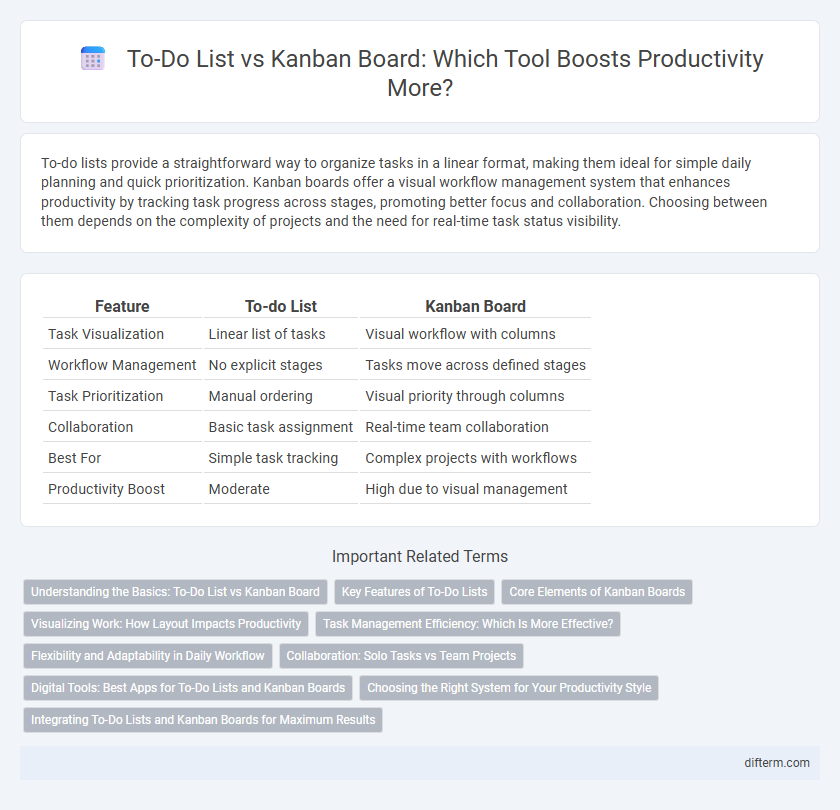To-do lists provide a straightforward way to organize tasks in a linear format, making them ideal for simple daily planning and quick prioritization. Kanban boards offer a visual workflow management system that enhances productivity by tracking task progress across stages, promoting better focus and collaboration. Choosing between them depends on the complexity of projects and the need for real-time task status visibility.
Table of Comparison
| Feature | To-do List | Kanban Board |
|---|---|---|
| Task Visualization | Linear list of tasks | Visual workflow with columns |
| Workflow Management | No explicit stages | Tasks move across defined stages |
| Task Prioritization | Manual ordering | Visual priority through columns |
| Collaboration | Basic task assignment | Real-time team collaboration |
| Best For | Simple task tracking | Complex projects with workflows |
| Productivity Boost | Moderate | High due to visual management |
Understanding the Basics: To-Do List vs Kanban Board
A to-do list presents tasks in a simple, linear format, emphasizing individual item completion and prioritization. Kanban boards use visual cards and columns to represent workflow stages, enabling real-time tracking of task progress and team collaboration. Choosing between them depends on task complexity, need for visualization, and whether the focus is on individual or collective productivity management.
Key Features of To-Do Lists
To-do lists offer a simple, linear way to organize tasks by priority and deadlines, enhancing focused task management. Key features include easy task addition, categorization, and progress tracking through checkboxes or priority labels. Their straightforward design enables quick updates and clear visibility of pending and completed items, optimizing daily productivity.
Core Elements of Kanban Boards
Kanban boards feature core elements such as visual task cards, columns representing workflow stages, and work-in-progress limits to enhance productivity by optimizing task management and reducing bottlenecks. Unlike traditional to-do lists, Kanban boards provide real-time visibility of task status and encourage continuous workflow improvement. This visual approach improves prioritization and team collaboration, driving more efficient project completion.
Visualizing Work: How Layout Impacts Productivity
To-do lists provide a linear, checklist-style format that helps prioritize tasks but may limit the ability to visualize workflow stages. Kanban boards use columns and cards to represent different phases of work, offering a dynamic overview that enhances task tracking and progress management. Visualizing work through a Kanban board layout can significantly improve productivity by clarifying task status and highlighting bottlenecks.
Task Management Efficiency: Which Is More Effective?
Kanban boards enhance task management efficiency by providing a visual workflow that helps prioritize and track progress in real-time, reducing bottlenecks and improving team collaboration. To-do lists offer simplicity and quick task capture but lack the dynamic overview and status tracking that Kanban boards provide. For complex projects requiring continuous monitoring and adaptability, Kanban boards are more effective in optimizing productivity.
Flexibility and Adaptability in Daily Workflow
A Kanban board offers greater flexibility in managing tasks by allowing users to visually track progress and easily reprioritize workloads based on real-time changes. In contrast, traditional to-do lists provide a straightforward checklist that lacks dynamic adaptability, making it harder to adjust to shifting priorities throughout the day. Adopting Kanban increases workflow adaptability, enhances team collaboration, and supports continuous task optimization in fast-paced environments.
Collaboration: Solo Tasks vs Team Projects
To-do lists streamline solo task management by providing clear, linear steps for individual focus and prioritization. Kanban boards enhance collaboration by visually organizing team projects, enabling real-time status updates and workload balancing across members. Effective use of Kanban boards boosts transparency, accountability, and team communication in complex workflows.
Digital Tools: Best Apps for To-Do Lists and Kanban Boards
Digital tools like Todoist and Microsoft To Do excel in managing traditional to-do lists, offering features such as task prioritization, reminders, and integration with calendars. For Kanban boards, apps like Trello and Asana provide visual workflow management with drag-and-drop task cards, real-time collaboration, and customizable columns to enhance project tracking. Choosing the right app depends on whether users prioritize linear task completion or a dynamic, visual overview of multitasking projects.
Choosing the Right System for Your Productivity Style
To choose the right productivity system, assess your work style: to-do lists excel for linear, task-focused individuals who prefer clear daily goals, while Kanban boards benefit visual thinkers managing multiple projects through categorized stages. Consider the complexity of your tasks and the need for flexibility; Kanban boards offer dynamic tracking with real-time updates, whereas to-do lists provide simplicity and straightforward task management. Matching your productivity style with these distinct features enhances task completion efficiency and maintains motivation.
Integrating To-Do Lists and Kanban Boards for Maximum Results
Integrating to-do lists and Kanban boards enhances productivity by combining task prioritization with visual workflow management, enabling clearer focus and efficient progress tracking. To-do lists provide structured, detailed itemization, while Kanban boards offer dynamic status updates and workload balance through columns like 'To Do,' 'In Progress,' and 'Done.' Leveraging both tools together maximizes task clarity, accountability, and adaptability in personal and team productivity systems.
To-do list vs Kanban board Infographic

 difterm.com
difterm.com